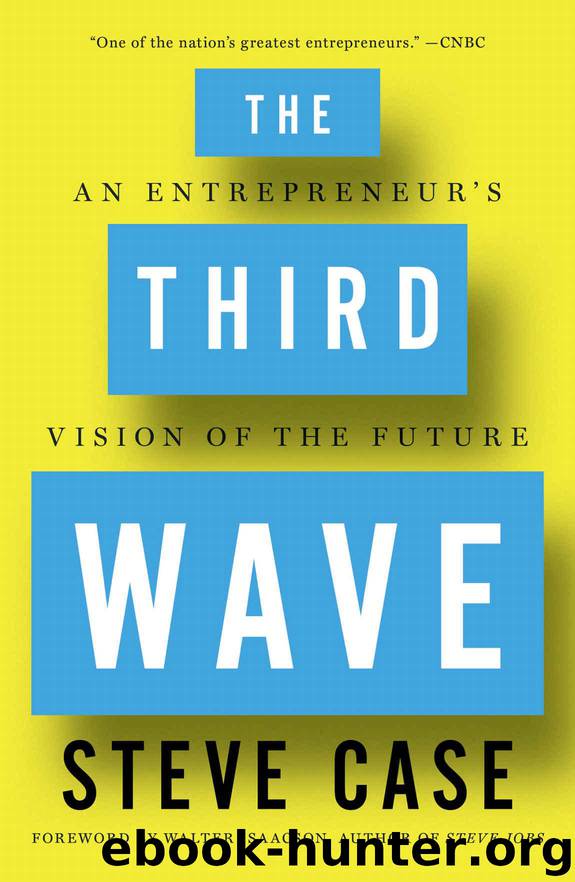The Third Wave: An Entrepreneur's Vision of the Future by Case Steve

Author:Case, Steve [Case, Steve]
Language: eng
Format: azw3, epub, mobi
Publisher: Simon & Schuster
Published: 2016-04-04T16:00:00+00:00
ENTER TIME WARNER
In the end, it was fairly clear that the best merger partner would be Time Warner. In many ways, the company had everything we needed. Time Warner had been formed a decade earlier through the merger of two media giants, Time Inc. and Warner Communications. Time Inc. was co-founded in the 1920s by a young entrepreneur named Henry Luce, who, in the process of selling Time, Life, Sports Illustrated, and Fortune to a growing, educated middle class, became the most influential publisher of the mid-twentieth century. Warner Communications had been built by Steve Ross, a charismatic company builder who went from owning parking garages to assembling one of the world’s largest media companies, which included the Warner Brothers movie studio, the industry-leading Warner Music company, and a range of other content businesses, including Lorimar-Telepictures. Later, Time and Warner (by then renamed Time Warner) also acquired Turner Broadcasting, led by the energetic, if idiosyncratic, Ted Turner. By the time we started contemplating a merger with them, Time Warner had serious heft—nearly $30 billion of revenue and $8 billion of profits. It had a trove of content brands—Time Inc., HBO, CNN, TBS, Warner Brothers, Warner Music, and many others. And it owned Time Warner Cable, one of the largest cable companies, so we would have a clear path to broadband, something we believed essential.
Broadband was coming, and, with it, a major threat to our dial-up–driven business. (In a world of smartphones, it’s amazing to think back to a time, less than fifteen years ago, when you couldn’t use the Internet and your phone at the same time!) Instead of phone lines, broadband used cable lines that we didn’t have open access to—and couldn’t get access to ourselves. Cable companies didn’t have to share their broadband lines the way phone companies had to with their dial-up lines. The regulations made it possible for them to shut out their competition altogether.
The “open access” fight, as it became known in the late 1990s, was a preview of the net neutrality fight that would come much later. Both dealt with the question of whether the owner of the “pipes”—the wire into your home—can control what you see over the Internet. During the open access battle, the cable companies took the view that they could just say no, refusing access to companies like AOL. During the net neutrality fight, they were subtler; they no longer sought to lock out competition, but they did seek to disadvantage it. They took the view that they could simply make some sites perform less well, unless those sites paid an extra fee to the cable company. And, in fact, when Tom Wheeler, chairman of the Federal Communications Commission (FCC), approved the commission’s net neutrality rules in 2015, he cited his fights with me in those early days as having been instructive to his decision.
We urged the government to intervene, giving us the same access to broadband as we had to phone lines. I spoke wherever and to whomever I could, whether to members of the FCC, members of Congress, or presidential candidates.
Download
The Third Wave: An Entrepreneur's Vision of the Future by Case Steve.epub
The Third Wave: An Entrepreneur's Vision of the Future by Case Steve.mobi
This site does not store any files on its server. We only index and link to content provided by other sites. Please contact the content providers to delete copyright contents if any and email us, we'll remove relevant links or contents immediately.
Hit Refresh by Satya Nadella(9038)
The Compound Effect by Darren Hardy(8808)
Change Your Questions, Change Your Life by Marilee Adams(7634)
Nudge - Improving Decisions about Health, Wealth, and Happiness by Thaler Sunstein(7615)
The Black Swan by Nassim Nicholas Taleb(7010)
Deep Work by Cal Newport(6877)
Daring Greatly by Brene Brown(6443)
Rich Dad Poor Dad by Robert T. Kiyosaki(6399)
Principles: Life and Work by Ray Dalio(6204)
Man-made Catastrophes and Risk Information Concealment by Dmitry Chernov & Didier Sornette(5921)
Playing to Win_ How Strategy Really Works by A.G. Lafley & Roger L. Martin(5913)
Digital Minimalism by Cal Newport;(5661)
Big Magic: Creative Living Beyond Fear by Elizabeth Gilbert(5610)
The Myth of the Strong Leader by Archie Brown(5422)
The Slight Edge by Jeff Olson(5346)
Discipline Equals Freedom by Jocko Willink(5281)
The Motivation Myth by Jeff Haden(5155)
Stone's Rules by Roger Stone(5026)
The Laws of Human Nature by Robert Greene(4996)
